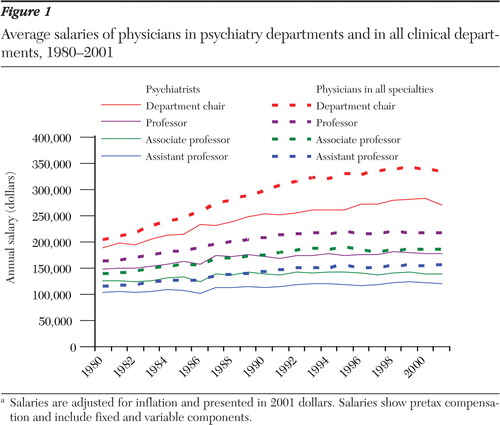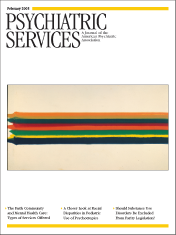Datapoints: M.D. Faculty Salaries in Psychiatry and All Faculty Departments, 1980-2001
In general, salaries for academic physicians continue to rise and keep pace with inflation despite changes in health care reimbursement, such as the expansion of managed care (1). This study compared trends in the salaries of faculty in academic departments of psychiatry with those of faculty in all academic departments.
Data were from the Association of American Medical Colleges' reports on faculty salaries from 1980 to 2001 (2). Figure 1 shows salaries by position and academic rank for psychiatrists and physicians in all specialties.
The trend lines show increases in salary for physicians in both psychiatry and all departments. Compared with salaries for physicians in all specialties, however, those for psychiatrists were lower and the trend lines were flatter. There were relatively large salary differences between chairs and professors that increased with time. In psychiatry the annual compound growth rate for chairs was 1.7 percent compared with .8 percent for professors; for all specialties, those rates were 2.4 percent and 1.4 percent, respectively.
The lower, flatter pay trends in academic psychiatry possibly reflect general inequities and deficiencies in financing for mental health. For the past 15 years the growth of behavioral managed care has adversely affected reimbursements for psychiatric services (3). The recruitment and retention implications of these trends are important because of the widely recognized need for clinician investigators in psychiatry (4).
Future investigations might examine which factors underlie variation in compensation levels among academic psychiatrists and whether the increasing differentials for chairs of academic departments parallel trends in other sectors. Future investigations also might examine whether the lower, flatter salary patterns among academic psychiatrists are reflected among nonacademic psychiatrists.
Acknowledgment
The authors thank Scott P. Haviland, M.B.A., and William C. Smith, M.H.S.A., for their assistance.
Dr. Dial is affiliated with the National Education Association, 1201 16th Street, Washington, D.C. 20036-3290 (e-mail, [email protected]). Dr. Haviland is with the department of psychiatry at Loma Linda University School of Medicine in Loma Linda, California. Dr. Pincus, who is coeditor of this column with Terri Tanielian, M.A., is with the department of psychiatry at the University of Pittsburgh School of Medicine and the RAND-University of Pittsburgh Health Institute in Pittsburgh.

Figure 1. Average salaries of physicians in psychiatry departments and in all clinical departments, 1980-2001
1. Studer-Ellis E, Gold JS, Jones RF: Trends in US medical school faculty salaries, 1988–1989 to 1998–1999. JAMA 284:1130–1135, 2000Crossref, Medline, Google Scholar
2. Smith, WC: Report on Medical School Faculty Salaries, 1979–1980 through 2000–2001. Washington, DC, Association of American Medical CollegesGoogle Scholar
3. Appelbaum, PS: Starving in the midst of plenty: the mental health care crisis in America. Psychiatric Services 53:1247–1248, 2002Link, Google Scholar
4. Research Training in Psychiatry Residency: Strategies for Reform. Institute of Medicine of the National Academies, 2003. Available at www.iom.edu/report.asp?id=15646Google Scholar



